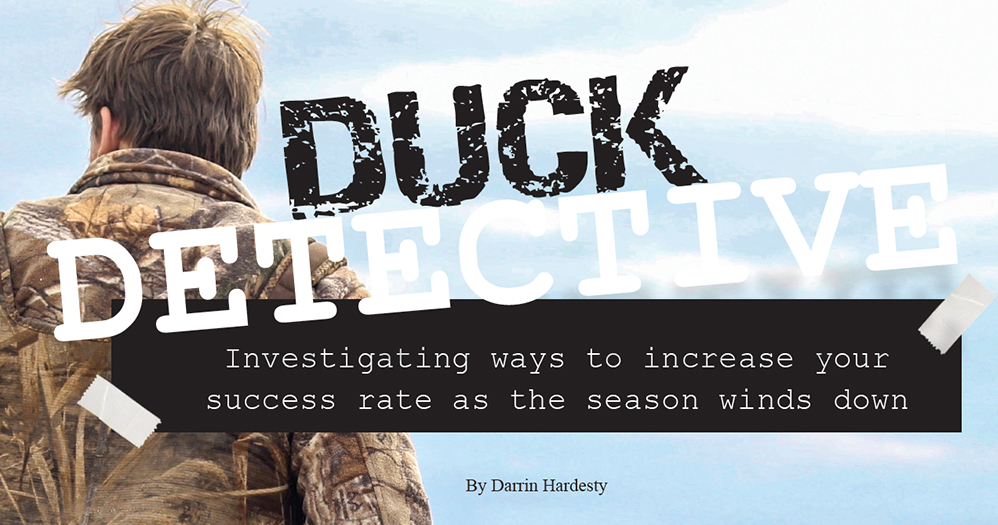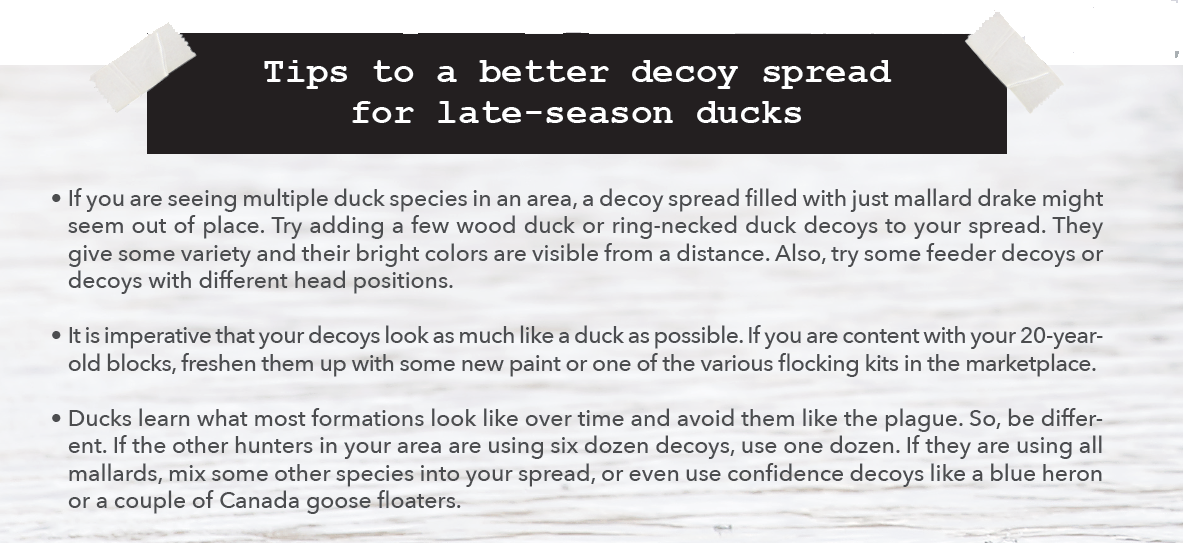Duck Detective
1/2/2019 2:45:57 PM
From MDWFP

It is mid-December and I get that long-awaited phone call from my brother: “You better get over here tonight. The ducks just showed up and we are going in the morning. You don’t want to miss this one.”
It almost sends chills down my spine because I know exactly what he is looking at through a spotting scope. A cold front just pushed through and brought thousands of migrating mallard, gadwall, widgeon, and pintail with it. If I miss this trip, I know I will regret it.
As an avid duck hunter, nothing is more frustrating than getting to a duck hole extremely early in the freezing cold, setting up and brushing in the blind, and throwing out all the decoys in the perfect pattern, just to watch the ducks work and land on the other end of the field, pond, or Wildlife Management Area (WMA) hunt unit. It is critical to do some pre-hunt scouting if you want your hunt to be a success. Whether you are a novice to the sport or a face-paint-donning die-hard if you do not hunt where the ducks are then you could be disappointed.
I was told early in my waterfowl-hunting years, “You have to hunt where the ducks are, not where you think they ought to be.” As life went on, I began to realize the truth to that statement. It is possible to harvest ducks in areas that simply look like good habitat, but if you spend time scouting different areas, your hunting success rates will increase dramatically.
Observe and Analyze
To be successful, hunters do not only need to scout, but they also need to pay attention to what could be causing ducks to use that area. Are they feeding or are they loafing? By checking the food contents of harvested birds you can determine what the birds have been foraging on. Being able to identify specific seeds from different plants can help determine if the ducks use moist-soil plants heavily or if they just flew in from a rice or corn field.
When you find a place ducks are using heavily, try to identify all of the different species and count approximately how many there are of each. This can help you determine which combination of decoys you will need to bring to mimic most closely the ducks in the area. Often duck hunters make the mistake of just bringing a dozen mallard decoys thinking that it will “get the job done.” Ducks have great eyesight. If you saw several widgeon, gadwall, or green-winged teal during your scouting, then bring a few of those species of decoys along.
Duck hunting can be an expensive hobby, but investing in decoys of multiple species can pay dividends during certain hunting situations. It is also important to pay attention to where the ducks are landing and their arrangement across the wetland. This can tell you where to set up the decoys, how many to bring, and how to arrange them. Are birds wading and foraging in very shallow water? If so, you may want to consider bringing a few full body decoys to mimic this behavior.

Concealment is Key
One key factor is to make sure all hunters and retrievers are well hidden. By the time ducks make it to Mississippi, they have seen just about every imaginable hunting scenario. Concealment is probably one of the most important factors in a successful hunt. When scouting a location, you need to evaluate the amount of available cover. Many of Mississippi’s WMAs provide a variety of cover types. Some WMAs are planted in soybeans with strips of corn left for cover, some are planted in rice, and others are managed for moist-soil plants. Before you go on a draw hunt or a stand-by, do your homework.
Depending on which habitat type you are using, try to mimic the cover type in which you will be trying to hide. During the winter waterfowl aerial surveys, Mississippi Department of Wildlife, Fisheries, and Parks (MDWFP) biologists fly over most of the Mississippi Delta and can see many duck holes. One of the most common situations seen is a duck blind in the middle of a rice field that is brushed in with oak or willow branches. These blinds provide cover no doubt, but from an aerial view, they stick out like a sore thumb. Look for thick cover close to where the ducks are. If none exists, plan to use layout blinds or boats and make sure any cover material you use to conceal yourselves or blinds closely matches the natural surroundings.
Save a Lost Hunt
I have been told my whole life that to kill ducks you have to find the proverbial “X.” I have often thought I had found the “X,” just to find out that it had moved about 300 yards away from me the next morning. Once the first flight of birds works your decoys and then lights on the other end of the duck hole or impoundment you are in, do not be afraid to make a swift decision and move. Mobility is key in many waterfowl hunting situations.
During the latter part of the season, birds can become decoy shy, so the ability and willingness to move your setup can often make the difference between a successful outing and coming home empty. I have left a full set up of decoys and blind, just to relocate a few hundred yards to where the ducks were working. Taking just a handful of decoys and hiding in some cover, I have taken a situation that was going to be long and frustrating and turned it into a productive hunt.
Many hunters hunt from permanent blinds, and while these blinds can provide comfort and quality shooting opportunities on some days, there might be some days when the birds land away from these blinds for one reason or another. Hunters should be willing to move away from these blinds at times to get in the proper position for success. Using marsh seats/stools in thick natural cover or using layout blinds in habitats that are more open can be effective. Even when you are positioned at the right spot, you might need to change your setup if the situation dictates.
For more information from Mississippi Department of Wildlife, Fisheries, and Parks on waterfowl and other migratory game birds, call (601) 432-2199 or visit www.mdwfp.com/waterfowl.
Darrin Hardesty is a MDWFP Waterfowl Program Biologist. Based in Cleveland, Hardesty helps landowners, leaseholders and wildlife managers statewide by offering technical guidance for their wetland habitat management.









